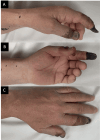Radial Artery Reconstruction After Iatrogenic Cannulation-Related Occlusion: A Case Report
- PMID: 38741851
- PMCID: PMC11090679
- DOI: 10.7759/cureus.58214
Radial Artery Reconstruction After Iatrogenic Cannulation-Related Occlusion: A Case Report
Abstract
A 59-year-old male, with a history of angiogram via the left radial artery during the workup for multi-trauma, presented to the hand clinic with a 14-day history of progressive critical ischemia in the left thumb and index finger, along with dry gangrene of the distal index fingertip. Radial artery occlusion was confirmed on imaging. The patient underwent radial artery thrombectomy, arterial reconstruction with vein graft, and amputation of the index fingertip. Postoperatively, perfusion to the thumb and index finger was restored, resulting in the resolution of associated pain and hypersensitivity. This case demonstrates the delayed presentation of ischemia following radial artery cannulation, which was successfully managed with radial artery thrombectomy and a saphenous vein graft.
Keywords: digital necrosis; ischemic gangrene; radial artery occlusion (rao); radial artery reconstruction; upper extremity revascularization.
Copyright © 2024, Schaeffer et al.
Conflict of interest statement
The authors have declared that no competing interests exist.
Figures




References
-
- Hand ischemia after radial artery cannulation. Valentine RJ, Modrall JG, Clagett GP. J Am Coll Surg. 2005;201:18–22. - PubMed
-
- Transradial cardiac catheterization: a review of access site complications. Kanei Y, Kwan T, Nakra NC, et al. Catheter Cardiovasc Interv. 2011;78:840–846. - PubMed
-
- Severe ischemia after radial artery catheterization: a literature review of published cases. Ying Y, Lin XJ, Chen MJ, Cao Y, Yao YT. J Vasc Access. 2022:11297298221101784. - PubMed
-
- Recommended standards for reports dealing with lower extremity ischemia: revised version. Rutherford RB, Baker JD, Ernst C, et al. J Vasc Surg. 1997;26:517–538. - PubMed
-
- Hand ischaemia following radial artery cannulation. Lee KL, Miller JG, Laitung G. J Hand Surg Br. 1995;20:493–495. - PubMed
Publication types
LinkOut - more resources
Full Text Sources
